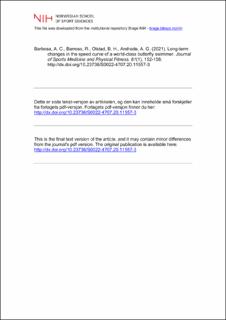| dc.contributor.author | Barbosa, Augusto C. | |
| dc.contributor.author | Barroso, Renato | |
| dc.contributor.author | Olstad, Bjørn Harald | |
| dc.contributor.author | Andrade, André G. | |
| dc.date.accessioned | 2022-02-15T09:23:32Z | |
| dc.date.available | 2022-02-15T09:23:32Z | |
| dc.date.created | 2021-01-22T13:00:03Z | |
| dc.date.issued | 2021 | |
| dc.identifier.citation | Journal of Sports Medicine and Physical Fitness. 2021, 61(1), 152-158. | en_US |
| dc.identifier.issn | 0022-4707 | |
| dc.identifier.uri | https://hdl.handle.net/11250/2978997 | |
| dc.description | I Brage finner du siste tekst-versjon av artikkelen, og den kan inneholde ubetydelige forskjeller fra forlagets pdf-versjon. Forlagets pdf-versjon finner du på www.minervamedica.it / In Brage you'll find the final text version of the article, and it may contain insignificant differences from the journal's pdf version. The definitive version is available at www.minervamedica.it. | en_US |
| dc.description.abstract | This study describes the changes in selected points of the speed curve, stroke rate (SR), and stroke length (SL) of an elite butterfly swimmer and examines their relationship with average speed (AS) and competitive performance. Over eight years, a male swimmer (50 and 100 m: 22.70 and 51.47 s) underwent 18 tests to assess AS, SR, SL, intracyclic speed variation (ISV), and eight selected points of the speed curve. Peak1 is the maximum speed in the upward kick executed during the arm recovery; peak2 is the maximum speed in the first downward kick after the arm entered into the water; peak3 is the maximum speed during the arm pull; and peak4 is the maximum speed during the arm push combined with the second downward kick. Min1, min2, min3, min4 corresponds to the minimum speeds found respectively before each peak speed. Official competitive results in 50 (50BF) and 100 m (100BF) within three weeks of the speed tests were registered. SR (r=0.736), ISV (r=-0.493), peak1 (r=0.555), min2 (r=0.558), and min3 (r=0.539) were correlated with AS. 50BF was correlated with AS (r=-0.658) and peak1 (r=-0.820), whereas 100BF with AS (r=-0.676), SR (r=-0.571), peak1 (r=-0.758), and peak2 (r=-0.594). AS increased by improving SR, peak1 and peak3. Increases in min2 and min3 indicate better transitions from resistive to propulsive phases. Selected points of the speed curve may predict butterfly performance. | en_US |
| dc.language.iso | eng | en_US |
| dc.subject | athletic performance | en_US |
| dc.subject | swimming | en_US |
| dc.subject | sports | en_US |
| dc.subject | analysis | en_US |
| dc.title | Long-term changes in the speed curve of a world-class butterfly swimmer | en_US |
| dc.type | Peer reviewed | en_US |
| dc.type | Journal article | en_US |
| dc.description.version | acceptedVersion | en_US |
| dc.source.pagenumber | 152-158 | en_US |
| dc.source.volume | 61 | en_US |
| dc.source.journal | Journal of Sports Medicine and Physical Fitness | en_US |
| dc.source.issue | 1 | en_US |
| dc.identifier.doi | 10.23736/S0022-4707.20.11557-3 | |
| dc.identifier.cristin | 1877128 | |
| dc.description.localcode | Institutt for fysisk prestasjonsevne / Department of Physical Performance | en_US |
| cristin.ispublished | true | |
| cristin.fulltext | postprint | |
| cristin.qualitycode | 1 | |
